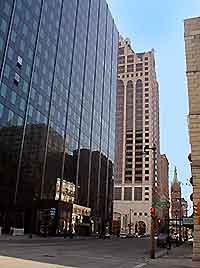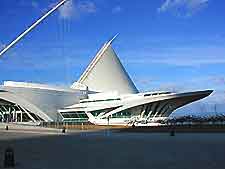Milwaukee History Facts and Timeline
(Milwaukee, Wisconsin - WI, USA)

Wisconsin's largest city, Milwaukee, has always been an important center for trade and transport, thanks to its strategic location on the banks of Lake Michigan.
What began as an area of French fur traders and missionaries has evolved into a beer brewing and industrial manufacturing sector. The history of today's Milwaukee is one of well-rounded urban living and a strong local economy.
Native American Tribes
Milwaukee's location is no great secret. This functional and fertile area had been the home of several Native American tribes for centuries, including the Fox, the Menominee, the Ojibwe and others, before the first Europeans showed up in the late 17th century. The French arrived first, mainly seeking fur for trade and souls to be redeemed. Alexis Laframboise established a trading post here in 1785, making him the first official European resident.
Bizarrely, two competing townships were established either side of the Milwaukee river, Juneautown and Kilbourntown. Intense rivals, neither recognized the other, and even their streets were deliberately planned not to align, which is why many of today's bridges are at an angle. Even the eventual name of the city went through several variations, until one newspaper set it straight in the mid-1800s.
A City of Immigrants
If anything, Milwaukee is famous for its huge immigrant population. The Germans, many of whom were fleeing the Revolutions of 1848, which plagued much of Europe, were one of the first groups to arrive en masse during the 1840s. Their influence came to dominate the city, with these settlers contributing much to the history of Milwaukee in terms of beer brewing and food.
The second-largest ethnic group to settle here was the Polish. Political oppression and poverty in their homeland pushed Poles towards America, and a huge number went straight to Milwaukee in the mid-1800s. As a result, the Southside district is today home to America's fourth-largest Polish community. Each June, the district's Polish Fest is a major event.
As word of Milwaukee's ethnic diversity and strong economy spread, the city became home to many other groups of people from across Europe. The ethnic history of Milwaukee can be traced through its distinct neighborhoods, like the Third Ward, the East Side and Lincoln Village. By revitalizing its historic neighborhoods, the city is slowly rediscovering its rich heritage and tapping into a lucrative local economy of restaurants, bars and shops that serve both residents and tourists.

Socialism and the Mob
It seems that the history of Milwaukee has always been one of breaking new boundaries and seeking opportunity via the American Dream. In the early 20th century, the city became the center of the American Socialist Movement, which pushed for new labor rights and new government priorities. Known as Sewer Socialists, the blue-collar organizers party to the movement weren't particularly popular among the establishment.
The 1920s Prohibition era put the city in the crosshairs of powerful gangsters from nearby
Chicago. Seeking unmarked territory, mobsters like Al Capone set up alcohol businesses in the city, since Milwaukee was mainly off the radar of federal Prohibition agents. The house where Capone made moonshine still stands on the street named after him in the Brookfield area.
Decline in the Rust Belt
Like most of the cities in America's Rust Belt industrial region, Milwaukee saw its fortunes decline in the 1960s and '70s, as long-time residents departed for greener pastures. The sudden loss of blue-collar jobs meant no work, especially for skilled workers. As a result, the downtown fell into somewhat of a decline.
In recent years Milwaukee has been rediscovering its history by pumping development cash into its many unique historic neighborhoods. As it stands, the city is heading in a positive direction by strengthening its local economy.
 Wisconsin's largest city, Milwaukee, has always been an important center for trade and transport, thanks to its strategic location on the banks of Lake Michigan.
Wisconsin's largest city, Milwaukee, has always been an important center for trade and transport, thanks to its strategic location on the banks of Lake Michigan.